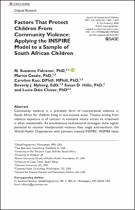| dc.description.abstract | Community violence is a prevalent form of interpersonal violence in South Africa for children living in low-income areas. Trauma arising from violence exposure is of concern in contexts where access to treatment is often unattainable. As simultaneous multisectoral strategies show higher potential to counter interpersonal violence than single interventions, the World Health Organization with partners created INSPIRE. INSPIRE takes an integrated approach coordinated across formal and informal settings of civil and private society. Responding to research paucity on methods that counter community violence in LMIC settings, this study employed a cross-sectional correlational design consisting of a sample of 2,477 children aged 10 to 17 years from the Young Carers 2009–2010 study conducted in a low-income, HIV-endemic province of South Africa highly affected by community violence. Multiple logistic regressions assessed individual and dose associations between four INSPIRE-based violence prevention strategies—positive parenting, basic necessities, formal social support, and school structural support—and direct and indirect community violence outcomes. Three strategies had significant associations with community violence outcomes: necessities (direct p < .001; adjusted odds ratio [AOR] = .57; indirect p < .01; AOR = .62), formal support (direct p < .05; AOR = .83; indirect p < .05; AOR = .73), and school support (direct p < .001; AOR = .53; indirect p < .001; AOR = .49). Combined interventions in direct and indirect community violence analyses demonstrated that children reporting a higher number of strategies were less likely to have experienced community violence. This outcome extends the results of longitudinal studies in South Africa highlighting social protection with care as a means to overcome structural deprivation strains, thereby reducing the likelihood of children’s exposure to community violence. Moreover, these findings uphold the INSPIRE model as an effective cross-sectoral approach to prevent and reduce the community violence that children experience. | en_US |

